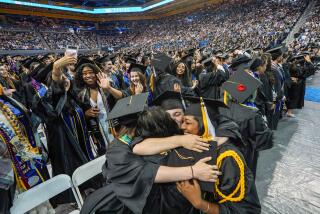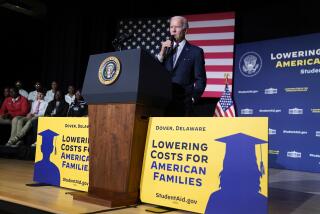Belt Tightening in Federal Aid Puts Squeeze on Students
WASHINGTON — Tom Gregory, a junior at Stanford University who is looking forward to a career as a doctor, has a lot of troubling questions on his mind. Can he hold up under the demanding workload? What should he specialize in? And looming over everything else is the cost: Can he manage the staggering loans he must take out to finance his training?
“It’s scary,” said Gregory, who already has obtained $7,500 under the federal Guaranteed Student Loan program and will need another $2,500 just to finish college. “A $10,000 debt sounds really ominous,” he said, “and I have other loans on top of that.”
Gregory’s plight typifies a basic change that has occurred among U.S. college students over the last several years as the federal government has tightened its belt on aid to college students.
Parents and the universities themselves are paying larger shares of college costs. But, according to financial aid directors at schools across the country, it is the students who are shouldering the biggest share of the new economic burden--most often in the form of mounting debt. Students and former students now hold an astonishing $51 billion worth of federally guaranteed loans, up from $15 billion in 1980.
While more students hold down part-time jobs, the dominant response to tightening finances has been a growing reliance on student loans. And, although some experts say that this trend forces students to accept responsibility and adds to their appreciation of higher education, others say that the size of the burden is unreasonable and triggers unwelcome consequences.
Large debts, for example, can discourage college graduates from attending graduate school and push them into high-paying careers. “We need poets and historians just as bad as attorneys and physicians,” said Kenneth R. Ostberg, financial aid director at Georgetown University in Washington.
At the Education Department, C. Ronald Kimberling, acting assistant secretary for postsecondary education, disagreed that the students’ growing loan burden has caused the shift to more financially rewarding professions. “Students were changing their majors before you had any vast shift in the loan distributions,” he said.
But Julianne Thrift, executive director of the National Assn. of Independent Colleges and Universities, said the prospect of large debts may be contributing to the fact that, while more members of minority groups are being graduated from high school, fewer are attending college. After years of increasing, the minority share of college enrollment declined from 15% in 1981 to 14% in 1983, the latest figures available from the Census Bureau.
Thomas Wolanin, staff director to the House Education and Labor subcommittee on postsecondary education, added that low-income families, lacking the perspective of more affluent families who are accustomed to going into debt when necessary, have “a great aversion to borrow(ing). If the students’ prospects are to go to college and incur a $10,000 or $20,000 debt or not to go to college, they are going to choose not to go to college.”
The Education Department’s Kimberling said that limited federal grant funds should be concentrated on the neediest students. If students are graduating from college burdened by substantial debt, he said, that is the fault of soaring college costs, not of the federal government.
Costs have indeed outpaced inflation. The cost of undergraduate education, including room and board as well as tuition, jumped from an average of $5,926 in the 1979-80 school year to $9,659 in 1984-85--an increase of greater than 60% during a period when the consumer price increase rose only 35%.
The reasons involve the nature of higher education. The steel and computer industries, for example, can take advantage of technological innovation to score productivity gains that help them hold down their costs. That doesn’t work for higher education, whose greatest costs are teachers’ salaries. In addition, Thrift said, college tuition in the early 1980s made up some of the ground lost to the soaring inflation of the late 1970s.
Universities have tried to meet the problem of mounting costs head-on by doubling their own scholarship money from $904 million in 1981 to $1.9 billion in 1983, according to the independent colleges group. From Harvard University to tiny Greenville College in Illinois, schools are soliciting funds from alumni and stepping up efforts to collect on their own defaulted loans to raise scholarship money.
“Certainly the scholarship program has been the fastest growing program of the institutional government,” said Barney Hoisington, financial aid director at Dartmouth College. “The institution’s scholarship budget has been rising about 20% a year over the last five years. Obviously, this can’t go on forever.”
And more students are working and paying part of their own way.
“Frankly, I’m really in favor of students working,” said Pat Bradley, a career counselor at Georgetown. “It’s good practice for entering the real world. Since many students here come from wealthy backgrounds anyway, it’s a good thing for them to start thinking about the realities, (such as) can I make money doing this?”
Pell Grants, the main federal grant program for college students, have grown only slightly in the 1980s. The volume of new federally guaranteed loans from banks and other private institutions, meanwhile, has grown by 50%.
Under the federal Guaranteed Student Loan Program, the federal government pays all interest costs while the student remains in school. During the 10 years after graduation, the student pays a below-market interest rate while paying off the loan. The government makes good on the loans of students who default.
Congress, at the Reagan Administration’s urging, tightened up on the program in 1981. No longer could all students automatically qualify for loans: Those from families with incomes greater than $30,000 had to demonstrate need. In addition, Congress slapped a 5% origination fee on the guaranteed loans.
Despite the program’s stricter requirements, its popularity has grown rapidly as a way to cope with soaring college costs. The average yearly guaranteed loan grew from $1,446 five years ago to $2,256 last year, Thrift said, and it is now common for students to be graduated with the four-year undergraduate maximum debt burden of $10,000.
Some educators say that the maximum loan amount, which was increased most recently in 1980, should be raised again to keep up with rising costs. Others argue that this would merely push undergraduates further into debt and encourage loan defaults. Of the $30 billion in guaranteed loans that are now at a stage where graduates should be repaying them, the Education Department says $3.1 billion is in default.
“It is legitimate to say that, while the society benefits from higher education, the chief beneficiary is the individual,” Ostberg said. “And so, he should be responsible for a share of the costs.” But there must be a reasonable balance, he added.
Congress must reauthorize federal aid programs for higher education by next October. Although some members of the education subcommittees are talking about raising the loan ceiling, there seems little chance that Congress, faced with $200-billion annual budget deficits, will beef up its grant program.
To campus financial aid directors such as Cornell University’s Don Saleh, that is the wrong way to go. “We’ve got our students borrowing as much as they can reasonably be expected to borrow,” Saleh said.
More to Read
Sign up for Essential California
The most important California stories and recommendations in your inbox every morning.
You may occasionally receive promotional content from the Los Angeles Times.










